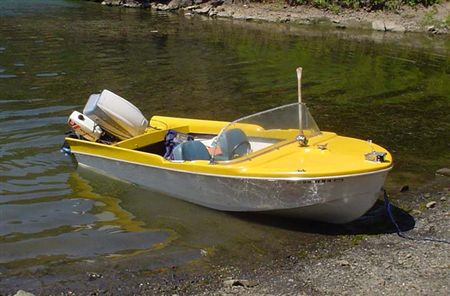In December, 2010, the Hood River Yacht Club honored Charles Deach, one of the founding members of the club and it's oldest known member with a lifetime membership. Charles was kind enough to share the following story and these priceless pictures.
Hello, I’m Charles Deach, and I must say I’m pleased to be acknowledged this way .

As I understand it, the members of the club are interested in a little of the history on the early Hood River Yacht Club. As a charter member and later commodore of the organization, I may be able to fill in with a few facts.
The original Hood River Yacht Club offered a lot of fun and productive outings for participants at its inception.
In the mid 1950s around a dozen of the local boaters decided to create the club with the intention of helping develop the surrounding Hood River area for safer boating.
Chance meetings on the river started several of us talking about putting together an organization for that purpose. After some discussion, the Hood River Yacht Club became an official entity. The first commodore elected was Vern Herbs, manager of the Dee Mill.
Included in the list of charter members are Morry Walton, Tom Senior, Dr. Ray Gaulke, Sr., Harlen Shank, Vern Herbs, George Bostwick, Sr., Earl Deitz, Dave Jensen, and his brother Luhr Jensen, Dick Simms, Ken Abraham and Al Hoffert. My apologies to anyone I haven’t included. After around 50 years I don’t seem to remember all their names. Suffice it to say, there were around 20 people interested in forming a club.
The bi-laws were loose such as qualifying for membership meant having a craft that was at least 30 inches long and could stay afloat for at least 60 consecutive seconds.
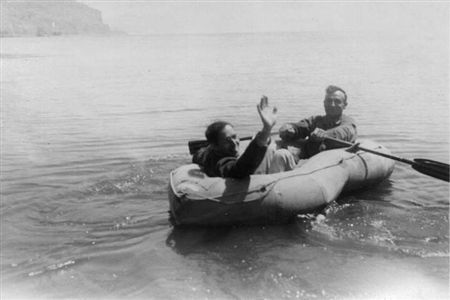
Obviously we were picky about our membership. There was no dress code and meetings were once a month. Members came from all walks of life and were only asked to be able to support the goals of the club.
Boats were few and far between on the river at that time. Most were smaller, the skiff type, a few that could be trailered, in addition to a couple docked in boathouses located under the southeast end of the Hood River Bridge. However, boating interest was increasing at that time and the craft population started building as well.
The river and surrounding area was considerably different in those days. No Dalles Dam, no McNary Dam, no The Dalles Bridge. The Hood River Bridge, was still relatively new at just over 30 years old.
The care of the area, now known as the marina and surrounding area, was nearly nonexistent. There were a few boat houses here and there and a few residences. Nichols Boat Works was in full swing, as well as JR Sawmill and a log moving business in the area where the 76 gas station is now located. As there was no marina at the time, there were only a few places where a small boat could be launched. As for docking, we just found places anywhere we could to tie up our boats on the riverbanks.
Pictures of the Deach Family boat, the Maryann
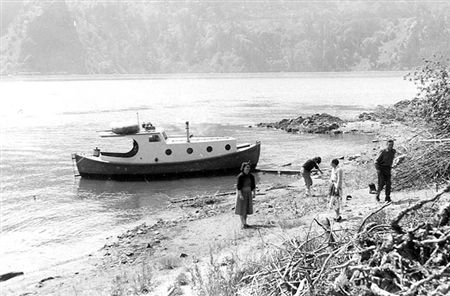
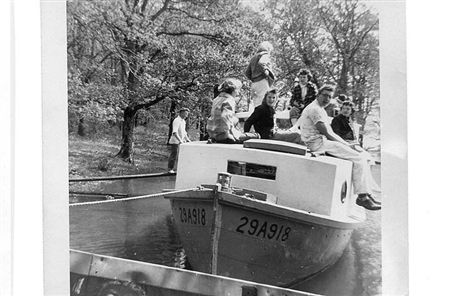
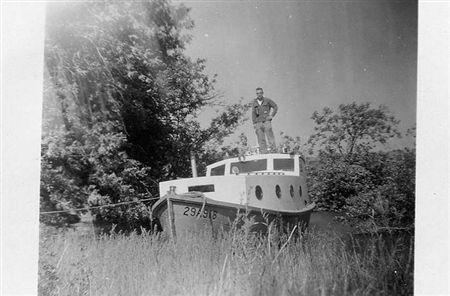
Our family had purchased the MaryAnn, a 26-foot, steel hulled lifeboat that offered many fun and exciting times during our ownership of 19 years. It was unique and dependable. Notice the smoke stack on the roof for the Neptune coal cooking stove in the galley. 4 bunks and a head below lent many possibilities for overnight excursions. We made numerous trips to Portland and one to Astoria. Its usefulness fit well with the yacht club activities. As you can see from the pictures, there were many people enjoying the Maryann. With the changes in the river, some sailing destinations no longer exist or are off limits to boaters as well as those that are still in use.
Seabury’s House

Wells Island, owned by Dr. Stanley Wells, later port manager, is still well known, But in the ‘50s and ‘60s Seabury Island, Seabury’s float house, and the Warnikas float house also played a big part in the local boating vocabulary. Seabury’s Island is located just south of the C portion of the hook and west of the treatment center. Both the houseboats were set on the east side of the island.
George Seabury definitely deserves mention as part of the early boating history in Hood River. An old salt, artist and former boat builder, he was a celebrity in those days. An individualist, Seabury lived on the river painting watercolors and scaring everyone else away from our boat that we tied up nearby. A real character. We’ll always remember him fondly for helping our son, Charlie, rebuild a small wooden sailboat called the Punkin.
Charlie and the Punkin
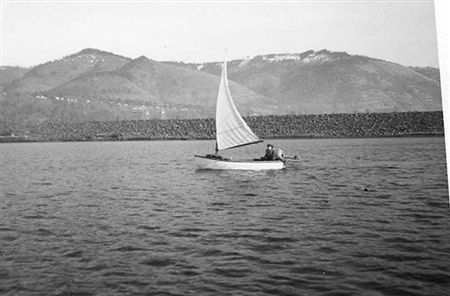
With the river ways being undeveloped and the high water created by the installation of the Bonneville dam there was a considerable amount of logs, floating trees, dead heads and general junk boats and accessories laying in wait to ruin our boating activity.
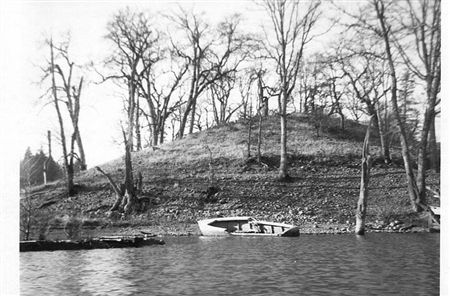
One of our projects was to clean out the deadheads, few floating logs and abandoned boats which took a couple of weekends using the steel hulled boats available in the club for towing. Other boat types were used for spotting the targets. It was a good time.
We felt quite successful in our endeavor until the local logging company sent us an enormous bill stating that we had collected logs on which they had salvage rights and hauled them away. Too bad… we had some interesting float house plans for those logs. As a side note, I’ll mention that we did not pay the bill and they didn’t approach us again.
There were also group overnight and day outings to various spots on the Columbia including Meyer Park and Merton Point, the spot now known as Struck Beach. In case you’re wondering, we did ask permission for that last spot.
I’ll also mention the clubhouse. There was an old abandoned float house a few hundred feet north of Nichols Boat Works. It was scheduled to be burned down when a couple of the club members got quite excited about the prospect of fixing it up and turning it into a clubhouse. After some wrangling with the port manager the deal was done.
Volunteer help being what it is, the structure never really became luxurious or used much. It has some personal history for me as the meeting where I become commodore in the mid ‘60s was held there as well as the meeting where the club members decided to let the organization take a sabbatical.
A launch site and a number of docs and boat slips were built in the mid 1960s located in the same area as what had become our clubhouse north of Nichols. A few boat houses were also springing up along the docks. Monthly rental spaces ran between $5-$10. As I remember it, there were around 20 or so boats docked there.
The Punkin with the USS Banning in background

For several years an attraction was docked at that site in the form of a retired Navy ship, the USS Banning. It’s shown at the back of the picture here. Tours were offered and a family lived aboard as caretakers. I spoke to a couple of sailors who had crossed the Pacific on that ship who referred to it as the USS Seasick.
I believe the Banning left us when the marina was moved to its current site.
As members became busy with other activities it was decided to let the club rest for the time being. Six years later I received a phone call saying that there was renewed interest with the sailboard activity and sailboats coming into the area. They planned to restart the club and asked if I would come down and open the first meeting. I accepted but declined to continue as commodore as my schedule would not allow the time. The meeting was opened, new officers were elected and the Hood River Yacht Club continues.
Thank you very much.
Charles Deach, now in his 90s and still active on the water, is the owner of the Maryann II
Maryann II
